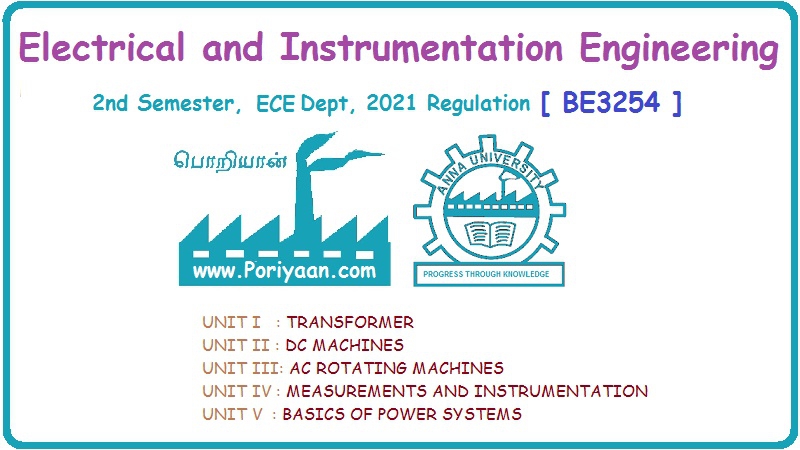Electrical and Instrumentation Engineering: Unit III: AC Rotating Machines
Single Phase Induction Motor
Construction, Working Principle, Double Field Revolving Theory, Characteristics
For general lighting purpose in shops, offices, houses, schools etc., Single phase supply is commonly used. There are numerous domestic applications like mixer, automatic washing machine etc.
SINGLE PHASE INDUCTION MOTOR
Introduction
For
general lighting purpose in shops, offices, houses, schools etc., Single phase
supply is commonly used. There are numerous domestic applications like mixer,
automatic washing machine etc. Which work on single phase supply, consisting of
single phase motors. The power rating of such motors is very small. Some of them
are even traditional horse power motors, hence also called fractional kW
motors.
Construction of Single Phase Induction Motors
Single
Phase Induction Motor has basically two main parts, one rotating and other
stationary. The stationary part in single phase induction motors is called
stator while the rotating part is called rotor.
The
stator has laminated construction, made up of stampings are slotted on its
periphery to carry the winding called stator winding or main winding.
The
number of poles for which stator winding is wound, decides the synchronous
speed of the motor. The synchronous speed is denoted as NS and it
has a fixed relation with supply frequency F and number of poles P. The
relation is given by:
NS
= 120 F / P
The
induction motor never rotates with the synchronous speed but rotates at a speed
which is slightly less than the synchronous speed. The rotor construction is of
squirrel cage type. In this type, rotor consists of uninsulated copper or
aluminum bars, placed in the slots. The bars are permanently shorted at both
the ends with the help of conducting rings called end rings. The entire
structure looks like cage hence called squirrel cage rotor. The construction
and symbol is shown in the Figure 3.29.

As
the bars are permanently shorted to each other, the resistance of the entire
rotor is very very small. The air gap between stator and rotor is kept uniform
and as small as possible. The main feature of this rotor is that it
automatically adjusts itself for same number of pole as that of the stator
winding.
Working Principle of Single Phase Motors
In
the single phase induction motors, single phase a.c supply is given to the
stator winding. The stator winding carries an alternating current which
produces the flux which is also alternating in nature. This flux is called main
flux. This flux links with the rotor conductors and due to transformer action
e.m.f gets induced in the rotor. The induced e.m.f. drives current through the
rotor as rotor circuit is closed circuit. This rotor current produces another
flux called rotor flux required for the motoring action. Thus second flux is
produced according to induction principle due to induced e.m.f. hence the motor
is called induction motor.
Important
difference between the two is that the d.c. motors are self starting while
single-phase induction motors are not self starting. Let us see why single
phase induction motors are not self starting with the help of a theory called
double revolving field theory.
Double Field Revolving Theory
According
to this theory, any alternating quantity can be resolved into two rotating
components which rotate in opposite directions and each having magnitude as
half of the maximum magnitude of the alternating quantity.
In
case of single phase induction motors, the stator winding produces an
alternating magnetic field having maximum magnitude of φ1m.
According
to double revolving field theory, consider the two components of the stator
flux, each having magnitude half of maximum magnitude of stator flux i.e., (φm/2).
Both these components are rotating are in opposite directions at the
synchronous speed NS which is dependent on frequency and stator
poles.
φf
= φb = φ1m/2

Let
φf is forward component rotating in anticlockwise direction while φb
is the backward component rotating in clockwise direction. The resultant of
these two components at any instant gives the instantaneous value of the stator
flux at that instant. So resultant of these two is the original stator flux.

At
start both the components are opposite to each other. Thus the resultant φR
= 0. This is nothing but the instantaneous value of stator flux at start. After
90°, the two components are rotated in such a way that both are pointing in the
same direction.
Hence
the resultant φR is the algebraic sum of the magnitude of the two
components so
φR
= (φ1m/2) + (φ1m/2) = φ1m. This is nothing but
the instantaneous value of the stator flux θ = 90°
Both
the components are rotating hence get cut by the rotor conductors. Due to
cutting of flux, e.m.f. gets induced in rotor which circulates rotor current.
The rotor current produces rotor flux. This flux interacts with forward
component φf to produce a torque in one particular direction say
anticlockwise direction. While rotor flux interacts with backward component φb
to produce a torque in the clockwise direction. So if anticlockwise torque is
positive the clockwise torque is negative.
At
start these two torques are equal in magnitude but opposite in direction. Each
torque tries to rotate the rotor in its own direction. Thus net torque
experienced by the rotor is zero at start and hence the single phase induction
motor are not self starting.
Electrical and Instrumentation Engineering: Unit III: AC Rotating Machines : Tag: : Construction, Working Principle, Double Field Revolving Theory, Characteristics - Single Phase Induction Motor
Related Topics
Related Subjects
Electrical and Instrumentation Engineering
BE3254 - 2nd Semester - ECE Dept - 2021 Regulation | 2nd Semester ECE Dept 2021 Regulation
